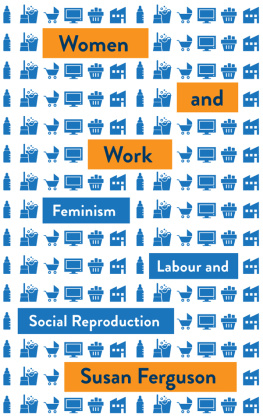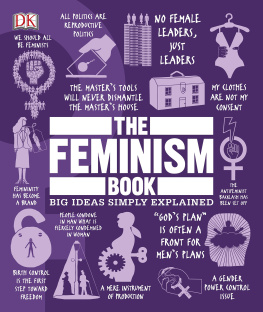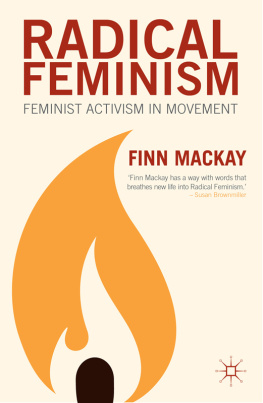Originally published in 1969 by Quadrangle Books. Inc.
Published 1998 by Transaction Publishers
Published 2017 by Routledge
2 Park Square, Milton Park, Abingdon, Oxon OX14 4RN
711 Third Avenue, New York, NY 10017, USA
Routledge is an imprint of the Taylor & Francis Group, an informa business
Copyright 1998 by Taylor & Francis.
All rights reserved. No part of this book may be reprinted or reproduced or utilised in any form or by any electronic, mechanical, or other means, now known or hereafter invented, including photocopying and recording, or in any information storage or retrieval system, without permission in writing from the publishers.
Notice:
Product or corporate names may be trademarks or registered trademarks, and are used only for identification and explanation without intent to infringe.
Library of Congress Catalog Number: 88-24928
Library of Congress Cataloging-in-Publication Data
ONeill, William L.
Feminism in America : a history / William L. ONeill.Rev. ed.
p. cm.
Includes bibliographical references and index.
ISBN 978-0-88738-761-6 (pbk.: alk. paper)
1. FeminismUnited StatesHistory. 2. WomenUnited StatesHistory. I. ONeill, William L. Everyone was brave. II. Title.
HQ1410.064 1988
305.40973dc19
88-24928
CIP
ISBN 13: 978-0-88738-761-6 (pbk)
i finished writing the first edition of this book in 1968, but it was not published until the fall of 1969, and most reviews of it appeared in 1970. The timing was crucial, for during this brief period, opinions on feminism changed drastically owing to the rise of womens liberation. Public attention was first drawn to it when radical feminists picketed the Miss America contest in Atlantic City on September 7, 1968. Charging that beauty contests degraded women, the demonstrators crowned a live sheep Miss America, and threw old bras, girdles, high-heeled shoes, womens magazines, curlers, and other instruments of torture to women into a freedom ashcan. More demonstrations followed, to be succeeded in their turn by street actions, zap actions, the hexing of masculine institutions by liberated witches, and the formation of numerous evanescent but often highly publicized radical caucuses, groups, factions, cults, and tendencies. The womens liberation movement was notable for its hatred of capitalism and the male sex, and for its outrageous rhetoric. These attributes lacked wide appeal, and as the 1960s receded, womens liberation became dated and finally irrelevant. But while it lasted, the movement made gender issues more combustible than they had ever been before.
Though less publicized at first, another kind of feminism had been developing for much of the decade. On December 14, 1961, at the request of Esther Peterson, a prominent Democrat and the head of the Womens Bureau, President John E Kennedy signed an executive order instituting the Presidents Commission on the Status of Women. It was the first official body ever to study the issue, and it gave birth to similar commissions on the state level. In 1963 Betty Friedan published The Feminine Mystique, a best-selling attack on inequality. Three years later Friedan became the first president of the National Organization for Women, formed by herself and some 300 like-minded men and women, many drawn from the status commissions. NOWs potential was demonstrated by its successful nationwide Womens Strike for Equality of August 26, 1970, which was believed to be the largest demonstration ever held on behalf of womens rights.
Quite by accident then, for I was drawn to the subject not by ideology but through my earlier research on divorce,
One might suppose that an opportune history with such an apt thesis would have been well received, and to some extent it was.
In preparing this new edition of Everyone Was Brave, I have profited from its original reception. Some criticisms of it were well taken and I have tried to address them here. The passage of time and the emergence of womens history as a major field of study have cast new light on certain questions, which I deal with in a concluding chapter written for this edition. I could not rewrite the entire volume according to present standards, usages, and tastes, and have not tried to do so. If this study is worthwhile, small delinquencies wont matter, and if not, laundering the text wont save it. Although I stand by my argument as originally made, it requires a few clarifications. The books chief weakness results from my failure to define equality. I originally used the term, as feminists did (and still do), in two ways. Most often it referred to what in the nineteenth century was called equal rights or womans rights, that is to say, equal opportunity. Yet almost from the start some feminists thought, at times anyway, about perfect equality, that is, not just an equal chance but an equal result.
Early in this century when the movement was at its peak, feminists believed if women had the same legal and political rights as men, and the same admission to desirable occupations, that would be sufficient. But experience has shown that equal opportunity involves more than merely seeing to it that women are not discriminated against. Because women remain the primary child-care providers, they are handicapped in the job market and frequently cannot take advantage of equal access even where it exists. For women to function on anything like same terms as men, they need not just open doors but supportive public policies. (In instances where men are the primary, or sole, child-care providers their needs are identical, so the programs should not be gender specific.) These would include guaranteed child-support payments in the case of divorce, ready access to high-quality nurseries and day care centers, paid maternity and paternity leaves, and whatever else is required to make working mothers competitive. This is a matter of fairness, but also of social health because there are national needsaggravated in recent years by the divorce crisis and the feminization of povertythat cannot be met except through government intervention.
Perfect equality is something else. One can imagine a society in which women would have equal rights and opportunities. It might resemble Sweden. What is nearly impossible to imagine is a society in which men and women are functionally identical, both sexes sharing equally in all aspects of life, an androgynous society perhaps, in which behavior would no longer be linked to sex. That they worried needlessly is, I hope, now clear.
The question I address in this book is why, despite having created a great movement and winning the vote, women failed to gain equal opportunity. Why did feminism disappear after 1920, even though the Nineteenth Amendment gave women only a symbol of equality rather than the thing itself? An obvious answer is that feminists in the nineteenth and early twentieth centuries could not have won equal rights whatever methods they employed. That is probably true, and I say as much in my preface. But whether their goal was reachable or not, women did organize to secure equality, and it matters that in doing so they chose some strategies and rejected others. Perhaps no single approach, or any combination of them, would have worked. But what feminists did do had consequences all the same, for themselves, for others, and for posterity. These need to be understood.








